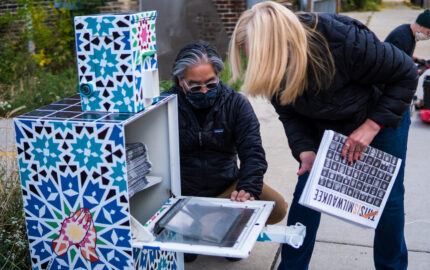At times like this, News Literacy faculty look at each other and quip, “What have we done to deserve such riches?”
The wisecrack reminds us to relish the meaningful work of keeping our finger in the leaking dike of fact-based self-governance, while governments and foundations waste time and money on supply-side solutions to a demand-side problem. Using fresh examples from each day’s tsunami of information, news literacy courses provably and durably change student habits, developing self-knowledge about biases while training the habit and skill of seeking truth, rather than accepting received truths.
Our students in Stony Brook University's news literacy program outscore their peers on civic knowledge and media savvy, years after they pass our brutal three-hour final exam. That’s no empty assertion, a plague news literacy vaccinates students against. Research out of the Shorenstein Center has documented the remarkable impact of the Stony Brook Model course.
Shortly after the election, my former student Ramy Noaman emailed me from Egypt to say he’d like to team up on a news literacy project for his homeland. “Seems the topics of news literacy overlap tremendously between and within the Egyptian counter-revolution and the Trump election, especially with the fake news controversy which may have affected the election outcome,” the 25-year-old United Nations University researcher said. Unprompted by me, he proposes to work on the demand side, helping those “lacking the knowledge filtration and verification skills that are often improved with education.”
I don’t begrudge anyone their ability to land government and private funds to underwrite journalism or the creation of earnest apps with phonetically-spelled names, but no amount of gamification, disruption, ideation, curation, aqui-hiring or data-mining “in the (journalism/media/civic) space” will make any difference at all if Americans don’t develop a taste for information imbued with the values of verification, independence and accountability.
Here’s a quick dash through election-year lessons a news literacy course uses to develop in students a taste for savvy truth-seeking.
Know Your Neighborhood Few citizens seemed to know what information neighborhood they were in this fall, as hoaxes and evidence-free assertions were treated as verified fact among people who never checked to see if the DC Gazette or Denver Guardian were anything more than a URL.
Analyze Evidence and Sources Students had hourly opportunities to navigate away from assertions from Bakari Sellers and Kayleigh McEnany and toward credible reporting from Hallie Jackson and Katy Tur, using reliable sources and ground-truthed evidence.
You Can’t Handle the Truth If You Don’t Know Your Biases Even when it was fact-checked to death, students could see in real time on Facebook that Democrats didn’t seem to care that Trump never told People Magazine that Republicans are the dumbest group of voters. Nor did Trump voters seem to care that Ford wasn’t actually cutting jobs to move small-car production lines Mexico. Paired with the news literacy course’s use of the Project Implicit website to learn their own biases, students could then monitor their own impulses to let fact-checking bounce off their confirmation bias like pea-gravel off a mud flap. BuzzFeed’s excellent documentation of shares, reactions and comments provided a near-perfect lesson about how hard we have to work to fight the universal deafness of humans to truth we don’t like.
Balance is Not Always Fairness and Bias Is in The Eye of the Beholder We teach students to be precise in their use of these non-interchangeable terms. A repetitive pattern of unfairness (bias) is pretty hard to prove. But people too often holler “bias!” when they confront information that merely contradicts their worldview. Trump followers used it liberally to batter Washington Post reporter David Farenthold for documenting the Trump Foundation’s violations of non-profit laws, violations the Trump Foundation recently admitted to. On the other hand, 96 percent of campaign donors who identified themselves as “journalists” contributed to Secretary Clinton, which provided excellent fodder for classroom debates about neutrality.
What IS News? (And Who Decides?) News literacy students are taught to eschew cheap conspiracy theories about agenda-rigging and look instead at the public’s tastes and the business pressures on journalists to build an audience. So classroom debaters could parse CBS CEO Les Moonves’ “damn good for CBS” quip about the Trump ratings bonanza and develop a more nuanced understanding of how broadcast show-runners were baited into covering his every stunt and speech. Sophisticated students looked at how quickly editors and producers broke their promises to eschew horse-race coverage, and how little attention was paid to governance issues.
Media criticism, of which there’s a surfeit, is not the point of news literacy training. Rather, the goal is to help students distinguish junk from journalism, articulate their observations and serve as thought leaders in their communities of friends and family, building demand for the good stuff.
Christine Powell, a former news literacy student now working as a reporter, doesn’t seem ready to blame Facebook for the swamp of disinformation this year. “Sure, Facebook could do more,” this 2014 graduate wrote to me via Facebook. “But people could also be more critical of their 'news' sources. The latest example I can think of is an illegitimate graphic of "the final popular vote tally," which looks like it was made in Word and cites nothing … It astounds me how many people I am friends with on this thing (Facebook), people I love and care about, even, (who) take whatever they see at face value and accept it as fact. The fake news sites would be less successful if only more people took a news lit course, don't ya think?”
I couldn’t say it better myself.



